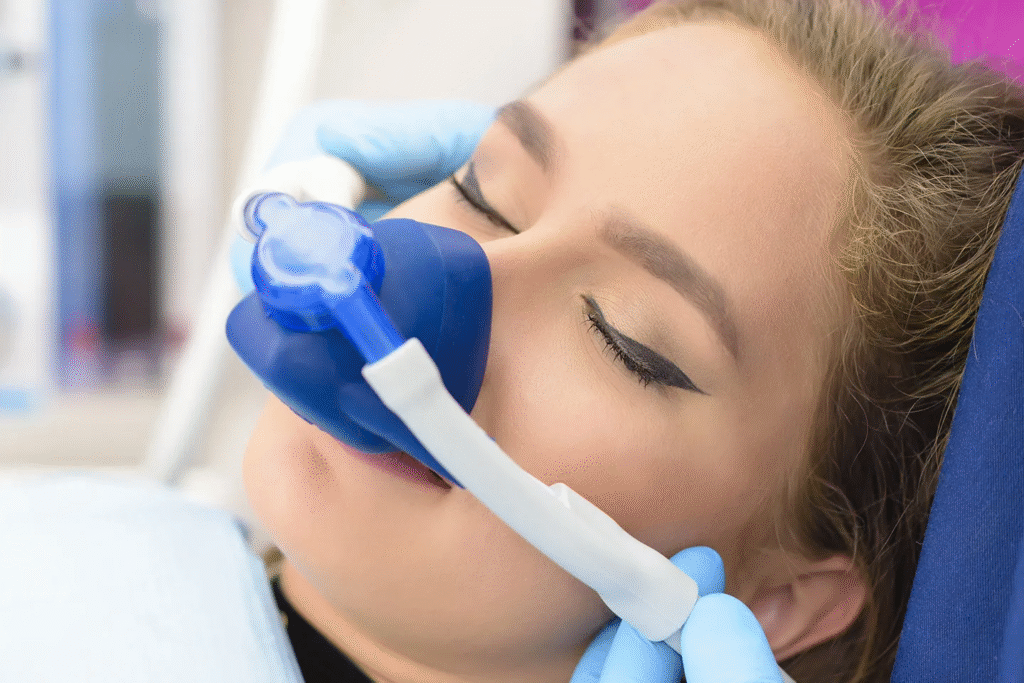What is Sedation Dentistry?
Sedation dentistry uses medication alongside local anesthesia to help patients relax during procedures. Sedation levels include:
- General Anesthesia: Complete unconsciousness for extensive surgical procedures.
- Mild Sedation: Minimal reduction in anxiety—patients remain alert but relaxed.
- Moderate Sedation: Deeper relaxation, often with little memory of the procedure.
- Deep Sedation: Patients are drowsy but conscious, with limited awareness of the surroundings.
Who Needs Sedation Dentistry?
Sedation is ideal for patients who:
- Need multiple treatments in one visit
- Suffer from dental anxiety or fear
- Have a low pain threshold or strong gag reflex
- Require lengthy or complex procedures
- Have difficulty sitting still
Types of Sedation Used in Dentistry
Our sedation options include:
- General Anesthesia: Inhaled or IV for complete unconsciousness during extensive surgeries.
- Nitrous Oxide (Laughing Gas): Inhaled for minimal sedation; wears off quickly.
- Oral Sedation: Pills taken before treatment for minimal to moderate sedation.
- IV Sedation: Intravenous delivery for adjustable moderate to deep sedation.
Treatments That Require Sedation
Sedation can enhance comfort for procedures such as:
- Cavity fillings and restorative work
- Tooth extractions and wisdom teeth removal
- Root canal therapy
- Crowns, bridges, and complex restorations
- Scaling and root planing
- Oral surgeries (bone grafts, corrective jaw surgery)
Benefits of Sedation Dentistry
Sedation dentistry helps by:
- Alleviating fear and anxiety so patients can receive needed care
- Allowing longer procedures in a single visit
- Reducing gag reflex and movement
- Ensuring a more positive dental experience
What Happens After Sedation Dentistry?
After sedation, you may feel groggy or dizzy for a few hours. A responsible adult should accompany you home. Most patients resume normal activities the next day, but avoid driving until the sedation effects fully wear off.
Preparing for a Sedation Procedure
To prepare:
- Discuss sedation options and preferences with your dentist
- Review your medical history, medications, and allergies
- Follow pre-procedure instructions regarding fasting and medication
- Arrange transportation home for moderate to deep sedation
FAQs About Sedation Dentistry
Q. What is the recovery time?
Recovery depends on the sedation level—minimal sedation wears off within minutes to hours, while deeper sedation may require a full day of rest.
Q. When can I return to work or school?
Most patients can resume normal activities the next day, provided they have fully recovered from sedation.
Q. When can I drive?
Avoid driving until all sedation effects have completely worn off, typically 24 hours after moderate or deep sedation.
Q. Can I eat or drink before my appointment?
Generally, avoid solid foods and dairy for 6 hours before, and liquids for 2 hours before. Follow your dentist’s specific guidelines.
Q. Are there any side effects?
Side effects are minimal and may include drowsiness, dizziness, or nausea for a few hours after the procedure.
Q. What should I wear?
Wear loose, comfortable clothing and avoid excessive accessories. Dressing in layers helps maintain comfort if your body temperature changes.
Q. Can I take my regular medications?
Usually yes, but inform your dentist about all medications. They will advise on any adjustments needed for safety.
Important Dental Terminology
- Nitrous Oxide – A mild inhaled sedative known as laughing gas for minimal anxiety relief.
- Oral Sedation – Medication taken by mouth to induce relaxation before dental procedures.
- IV Sedation – Intravenous delivery of sedatives for controlled moderate to deep sedation.
- General Anesthesia – Medication that induces complete unconsciousness for surgical procedures.
